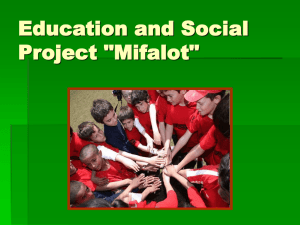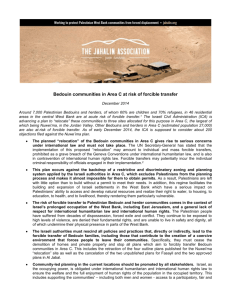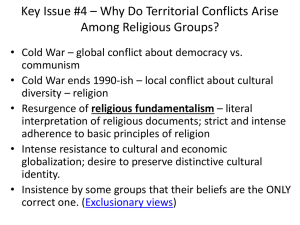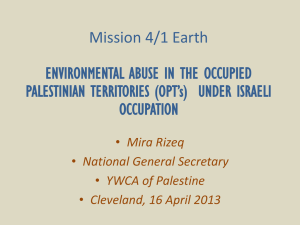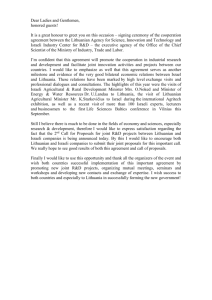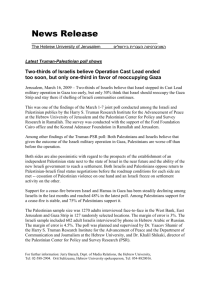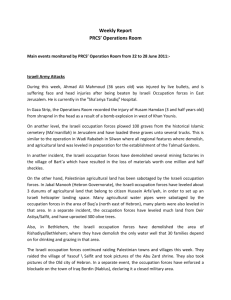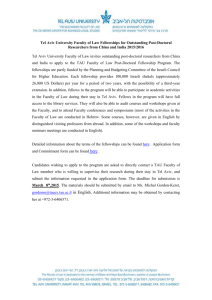NOMADIZING FROM AFFECT TO AFFECT - Hal-SHS
advertisement
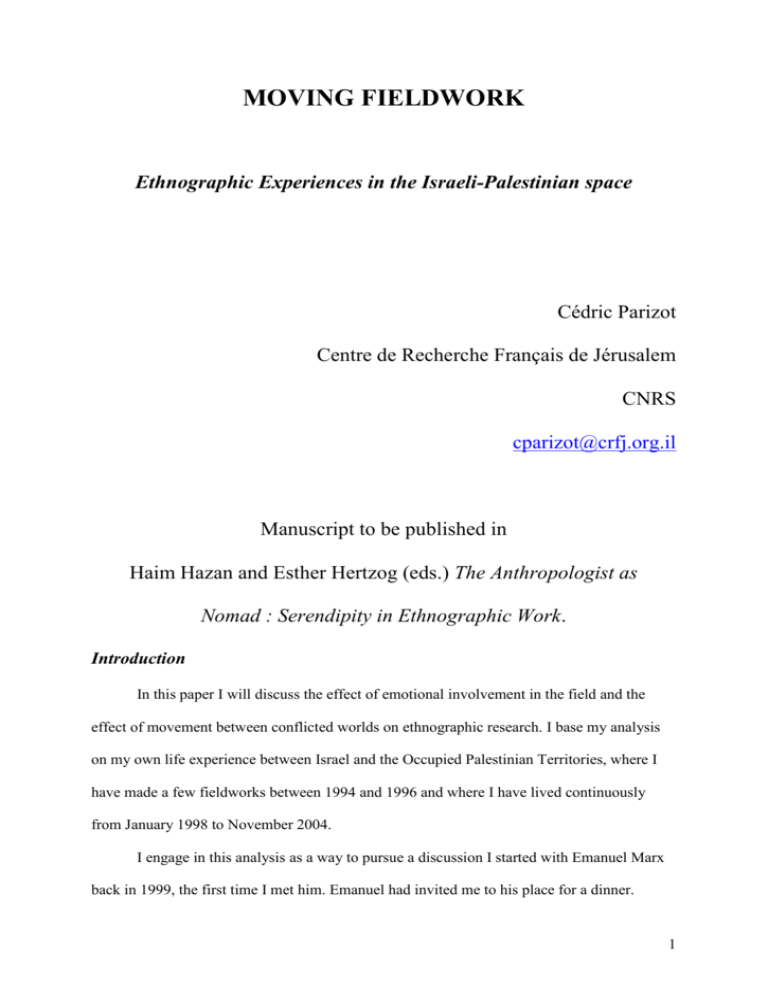
MOVING FIELDWORK Ethnographic Experiences in the Israeli-Palestinian space Cédric Parizot Centre de Recherche Français de Jérusalem CNRS cparizot@crfj.org.il Manuscript to be published in Haim Hazan and Esther Hertzog (eds.) The Anthropologist as Nomad : Serendipity in Ethnographic Work. Introduction In this paper I will discuss the effect of emotional involvement in the field and the effect of movement between conflicted worlds on ethnographic research. I base my analysis on my own life experience between Israel and the Occupied Palestinian Territories, where I have made a few fieldworks between 1994 and 1996 and where I have lived continuously from January 1998 to November 2004. I engage in this analysis as a way to pursue a discussion I started with Emanuel Marx back in 1999, the first time I met him. Emanuel had invited me to his place for a dinner. 1 While I was telling him about the elections and local politics in the Negev, he recommended me to look at people’s actions and choices as highly emotional. I did it as well as I did look at my own behaviour and wandering on the field as emotional. It took me time to make sense of it and this article is a first attempt to articulate these thought on a piece of paper. Emotions and movements were narrowly related in my own experience on the field and in my life in the Israeli-Palestinian space. Throughout my ten years in this region, I have been constantly moving from place to place. Each movement represented a displacement away from a universe in which I had established long-term emotional and power relations with people; consequently each movement impacted my emotional state. Between 1994 and 1999 I stayed in the Negev where I lived mostly among my Israeli Bedouin hosts in the villages of ‘Abde (Avdat in Hebrew) and the ‘Arab al-‘Ugbi as well as in the townships of Hûra and Rahat. The rest of the time, I remained in Sde Boqer Campus (Ben Gurion University), living in caravan accommodation while making regular visits to the Occupied Palestinian Territories (OPT). Then in autumn 1999, I moved to Tel Aviv for three years where I lived with my girlfriend. At that time, I kept on visiting my friends in the Negev and the OPT. In 2002 I moved back to the Negev to work for the French Embassy as the head of the Cultural Center in Beer Sheva. There my girlfriend and I parted. In 2003, I met my current companion, Noa. We left Israel to go to France in 2004, and married there a year later. Being caught up and involved in emotional relations is a common experience for anthropologists doing long-term fieldwork and, as such, it has been broadly discussed in the literature (see for example, Matsunaga 2002). Scholars have also discussed how ethnographic observation, description and understanding may be deepened by the sharing of emotional intensity in the field (Favret-Saada 1990) and even by taking sides with the hosting community (Swedenburg 1995). 2 Yet, being both emotionally affected by the field and moving between conflicted realms, such as those prevailing in the Israeli-Palestinian space, allows a privilege ethnographic perspective. Of course, such moves can occasion many difficulties and obstacles. At first glance, these obstacles could indicate the failure of one's research project. For instance, when doing my fieldwork among the Bedouin in the Negev, I developed deep emotional ties with my hosts. Consequently when I moved to Tel Aviv in 1999, I experienced extreme difficulty in relating to the Jewish Israeli environment that I encountered there. I also discovered the biased perceptions of Jewish Israeli society I had internalized after living almost exclusively with Palestinians from Israel and the West Bank. Faced with such gaps between these worlds, and experiencing difficulties in bridging them, I felt that I had failed in my research project. Yet in struggling to overcome these shortcomings I unconsciously acquired the practical experience to deal with these gaps and boundaries; I found myself imitating and reproducing the daily practices that my hosts employed to manage these conflicted worlds and realms. In other words what at first I regarded, a priori, as a sign of failure in my anthropological research, now appeared progressively as a methodological tool that allowed me to better understand part of the mundane processes structuring boundaries and gaps in the intensely conflicted Israeli-Palestinian space. In discussing my own experiences I do not intend to confess the mistakes I made and the sins I committed during this period; these I prefer to keep them to myself. Rather, I see it as an exercise in ethnography; viewing the anthropologist as an object. Like Richard Goodman (2000), I strongly believe that looking at how a society affects the behaviour of the anthropologist can teach us a lot about that society and some of its internal dynamics. I will discuss my travels from emotions to emotions during my stay in the IsraeliPalestinian space in three stages. First, I will describe the conditions in which I became completely caught up in emotional and power relations with my Bedouin hosts and friends in 3 the Negev; as the field took control over my own perceptions I lost any distance and critical understanding of what I was observing. In the second part, I will describe how these extremely situated perceptions strongly shaped my interactions in Jewish Israeli society when I moved to Tel Aviv. Yet, as I will explain in the third part, these apparent shortcomings were not markers of failure in my ethnographic project. On the contrary, after a long, hard and complex struggle I believe that I deepened my ethnographic insight. This process did not merely provide me with a privileged access to the local system of signifying practices based on the politics of emotions, but it also gave me practical experience of how emotions can mark out boundaries in spaces, and provoke their embodiment. In other words this process showed me that drowning in emotions, and the difficulties of movement it entails between Israeli and Palestinian, Jewish and Arab conflicted worlds, should have been set as a methodological target from the very beginning of my fieldwork. BEING CAUGHT UP IN THE FIELD I do not regard my successive fieldwork in the Negev between 1996 and 1999, as wellplanned, organized ethnographic investigations. In fact they were rather poorly prepared. From the subject I chose to the location of my fieldwork, I seized the opportunities that were presented to me. I think that my poor preparation, together with my limited knowledge of the region and my status as a foreigner, placed me in a relation of extreme dependency toward my hosts. Hence, instead of just observing and collecting interviews, my ethnographic experience forced me to manage in challenging social and affective environments. I could not remain distant, discrete and neutral while observing my hosts. On the contrary, I had to earn their sympathy and their recognition. I had to enter emotional and long-term relationships, I had to let myself be caught up by the field and to be deeply affected by it. 4 Finding a subject and a place to live In January 1996, planning to immerse myself in the Bedouin population in the Negev, I looked for a place to live either in one of the planned townships or in the slums scattered on the periphery of Beer Shevai. My original aim was to study patterns of urbanisation in this population. Yet new general elections were due to be held on May 29, 1996 to choose the new Israeli Prime Minister and the Members of the Knesset (the Israeli Parliament). Gideon Kressel, then a professor at Ben Gurion University, advised me to seize the opportunity of the election campaign. I did not know much about electoral politics but the idea was exciting. At the end of January Gideon put me in contact with Nûri al-‘Ugbi (Abu Salâh) the head of a human rights NGO “The Association for Defence of Bedouin Rights in Israel”. When I met Abu Salâh I explained that I was looking for a place to live in a Bedouin township, in order to learn Arabic and observe the electoral campaign. Abu Salâh offered to welcome me into his home provided that I helped in the association every week. I agreed to his generous offer, and followed him that same day to his village close to Hûra. When we arrived at his home, he introduced me to his brothers and to the other members of his family; I stayed with Abu Salâh for a few days. Subsequently, I was invited to be the guest of his brother, Abu Sâmi, who eventually became my permanent host. Abu Salâh, Abu Sâmi and their respective families, as well as the other members of the village, displayed great generosity. They offered me their homes and took me into their confidence for the next six months, following which I returned to France. When I came back to the Negev, in January 1998, they invited me to stay in their village for another six months. In November, 1998 I move to Rahat, in order to observe the municipal election campaign, and later the general elections of May 1999. Earning Recognition 5 Considering my initial position, it was not easy to gain legitimacy and sufficient respectability among Abu Sâmi’s and Abu Salâh’s families. In 1996 when I started my fieldwork as a graduate student, I was 24, much younger than an average Israeli graduate student. My level of Arabic was that of a beginner, my Hebrew non-existent, and I had very little knowledge of Israeli and Palestinian society. These drawbacks prevented me from claiming any academic credibility. Worse, many people regarded me as an idiot. It was then that I realized the arrogance of French academia, sending students to perform ethnographic investigations within populations and countries whose languages they do not speakii. My position was absurd and I had to find ways to redefine it as quickly as possible. I had to acquire a better level of Arabic as well as to learn rules of proprieties and, of course, to get familiarized with the basic information concerning local and national politics. Thanks to the unlimited patience and generosity of my hosts, I managed to take my place among them and acquire sufficient skills to enable me to carry out my fieldwork investigation. I never managed however to change the first impressions I made during my first stays: that of a young exotic curiosity constantly asking questions, whose relevance was to be determined. Nevertheless, later in November 1998 I did partially manage to change my status when I moved to Rahat and settled at Abu ‘Isâm’s house. This time I started my investigation with better knowledge and position. I was already quite fluent in Arabic, I was more familiar with local politics and I was no longer a graduate but a PhD student. Yet, even in Rahat, I evoked amusement and even contempt among some of the local elites. Sometimes, I felt like the (Inspector) Colombo character! Although my knowledge would increase progressively to the point of mastering nuances of local politics, people still regarded me as stupid. I still remember interviews held in the city hall of Rahat which eventually turned into sessions in which I was totally overwhelmed and patronized by my interlocutors. My interviewees became the interviewers while I became a funny attraction, 6 subjected to mockery and jokes. These experiences made me realize that if anthropological investigations can involve deep asymmetric relations, it is not always to the disadvantage of the people observed by the anthropologist. Contrary to what is often assumed (see, among others, Bourdieu 1998: 1393), symbolic violence does not always exercise itself on the interviewee but, in certain circumstances, it can also exercise itself on the interviewer (Chamboredon et al. 1994). All in all, I was not only caught up in power relations, but the field started to gain control of my unfolding research. This tendency persisted because the very conditions of my investigation gave me no way to escape it. Affective Relations, Affected Perceptions Emotions became central to my relations with people; not only did I develop long term relations with them but I also compensated for my feeling of isolation from my country, family and friends by directly re-constructing affective and power relations in the Negev. Abu Sâmi, Abu Salâh and Abu ‘Isâm, who were my elders, the ones who introduced me into their world, and the ones on whom I was relying economically and socially, progressively became my mentors and their respective families my shelter. Given such deep affective links with my hosts, I internalized their narratives with little criticism and these became the sole means by which I could make sense of the surrounding reality. In 1996, at the very beginning of my field work, not knowing much about anything, I grasped any story and narrative as I learned words to build up my Arabic vocabulary. I added these discourses to a more or less coherent patchwork that I was mentally sowing to make sense of the unknown surroundings. It is on such grounds that I tried to understand the position of the family of my hosts in relation to their neighbours, and to understand the 7 content of the relations between my Bedouin hosts and the dominant Jewish Israeli society. These stories did not just make sense because they were enunciated by people I respected, and in whom I had total confidence, but also because they were loaded with emotion. Finally, reproducing such narratives was a way to unconsciously acknowledge the new affective yardsticks I acquired in the Negev. It was also a way to publicly claim my belonging to this new social and cultural environment whose recognition I was seeking. Consequently, I developed extremely situated perceptions. Locally I was not integrating myself into the Bedouin society of the Negev but into the specific families and networks of my hosts; I made their points of view my own. In November 1998, during the municipal elections of Rahat, I actively identified with one of the dominant factions lead by the cousin of my host. I identified with the electoral struggle of its members because I was following them around, engaging in their discourse, and sharing their moments of anxiety and excitement. On a broader level, I sided with my hosts and the Palestinians in their conflict with Israel. How could I have done otherwise? Living in the village of Abu Salâh, in the slum of ‘Abde and in the planned township of Rahat, I shared their difficult material conditions of life, I witnessed and even found myself directly exposed to the violence of the Israeli police. My regular trips to the OPT also made me see the violence of the Israeli occupation. These experiences provided me with many incidents to illustrate the discourse of my Bedouin and Palestinian hosts about the toughness of their relations with the dominant Israeli society. Each incident contributed to better ground my narratives and perceptions of the general situation. Finally, as it happened to Clifford Geertz and his wife (Geertz 1973) when they run away from the Balinese police with the local inhabitant during cock fight, I found out that sharing experiences of violence helped me develop mutual feelings of closeness with my hosts in Abu Salâh’s village, in ‘Abde and in Rahat. 8 In the summer of 1999, when I stopped my fieldwork investigation in order to live in Tel Aviv, my perceptions were over-determined by the specific relations I developed in my fieldwork. It took me a long time to realize this, and to adopt a critical attitude toward these perceptions. This did not really happen during my stay in Tel Aviv, but rather during my moves from the Negev to Tel Aviv (1999) and later from Tel Aviv to Beer Sheva (2002). DISPLACEMENTS IN CONFLICTING WORLDS Living in Tel Aviv did not take me through a process of detachment from the field, but through a process of confrontation of conflicting perceptions and emotional states. While I could not get rid of the perceptions I had acquired during my fieldwork, I developed new representations and feelings corresponding to my new environment. It was by trying to manage these conflicting perceptions that I progressively made sense of the gaps prevailing between the world I had left and the one to which I was introduced, as well as the difficulties in bridging them. Surprises For a little while, I really thought that living in Tel Aviv would free me from the emotional and social challenges that I experienced in the field. I was planning to write my PhD and to start a new life. The atmosphere of the city, the rhythm of my new existence, as well as my daily activities made me feel like I was back in Paris. Moreover, living with my girlfriend whom I had met a few months earlier, as well as developing long-term relations with her family and friends, introduced me to a whole new universe of relations, emotions and perceptions. I had put an end to my fieldwork, and had stopped trying to observe and decipher the reality around me. 9 Yet, I could not forget what I had seen and experienced in the Negev and in the OPT. These past experiences actually made it extremely difficult for me to relate to the part of the Jewish Israeli society I had met without thinking of the Israeli-Palestinian conflict and the Jewish-Arab relations inside Israel. I became more and more obsessed with the gaps I noticed between the life I was now enjoying and the one I had experienced among the Bedouin; I even developed a certain resentment towards the dominant Jewish society. Significantly, despite going regularly to the Ulpaniii as well as being continuously surrounded by the language, for a long time I did not manage to learn Hebrew. This resentment intensified in the face of the gaps of knowledge separating Israeli Jews from the Palestinians. Apart from my girlfriend and some colleagues who where themselves involved with Palestinians through their work, most of my Jewish Israeli friends had absolutely no idea what was happening in what they called the “shtakhim”iv and even in places populated by Israeli Palestinians. It seemed to me that they were not even aware of their Palestinian neighbours. Their lack of knowledge and awareness were proportional to their surprise in September 2000, when the second Intifada broke out. Many of my Jewish friends thought that the period of the implementation of the Oslo Agreements (1994-2000) had brought dynamics of peace and prosperity. They did not realize that during that same period Israeli policies of control concretely imposed on Palestinians more obstacles of movement, a harsh economic crisis, and the constant shrinking of space. Surprisingly, I noticed even more ignorance among Israeli Jews concerning the Bedouin in the Negev; not a single friend of mine was aware of what was happening in the south. Some had more knowledge about Israeli policies in the Palestinian Territories than about the forced policy of the urbanisation of the Bedouin. Actually, none of my friends had ever entered a Bedouin township or an unrecognized village. This explained the odd questions 10 they sometimes asked, such as how hard it was to sleep in tents, and whether the traditional Bedouin coffee they heard so much about was really that good! Given the degree of interpenetration between the populations and the short distances between populated areas, it was very difficult for me to understand the lack of knowledge Israeli Jews had about their Palestinian neighbours, and about the effects of the occupation. I was all the more struck by the total absence of knowledge concerning the situation of Israeli Palestinians. Painful bridging Yet, I soon experienced myself the difficulty of moving from one world to another. During this period, I encountered difficulties in moving back and forth between Tel Aviv and the Negev and between Tel Aviv and the OPT. On the one hand, one of the most dynamic cities of the country, and the entire Mediterranean littoral, in terms of cultural and economic activities. On the other, the extremely poor Bedouin slums and townships, as well as the sorrowful Palestinians cities, half-destroyed in the wake of Israeli incursions during the period of the Second Intifada (2000-2006). Travelling back and forth would thus systematically confront me with the extent of ethnic inequalities and discrimination prevailing in Israel, as well as with the increasing damage inflicted by the Israeli repression of the Intifada. Such actual experiences were even more difficult to manage when returning to Tel Aviv; I could not share them with my close Jewish Israeli friends. Voicing my discourse and my emotions was inadmissible to them as it appeared to place them in the role of executioner and the Palestinians in the role of victim. From this perspective, speaking out about my actual experiences would be taken directly as an accusation or an attack. This is all the more true as in a situation of conflict nobody discusses the conflict with detachment. I myself was emotionally affected by the suffering of my friends in the Negev or in the OPT. I would thus 11 discuss their situation with a lot of emotion and with little control. My Jewish Israeli friends were even more emotionally involved in the conflict than I because they served in the Israeli army, or had kin or close friends serving. Some had friends or kin who had been wounded in clashes with the Palestinians, or in suicide bombings. Like my Palestinian friends, they were directly or indirectly affected by the conflict but, unlike me, they did not have the choice to go back to France if they wanted to. All in all, speaking about my actual experience of the conflict when living in Tel Aviv was perceived as a direct confrontation. It questioned the very affective relations I was trying to develop with my Jewish Israeli friends. Such difficulty in speaking out created a permanent unease during my stay there. Indeed, but for a few exceptions, I found myself in a situation where I could not voice my frustrations caused by the conflict with the very people I regarded as potential confidants. I became aware of this difficulty in communication through a series of violent exchanges following the outbreak of the second Palestinian uprising in September 2000. One such incident happened about a month into the uprising. I remember I was sitting in a café in Tel Aviv with a couple of close friends and they started talking about a clash in the region of Nablus between the Israeli army and Palestinians. The TV news had reported many Palestinians dead after the soldiers opened fired on a crowd trying to capture an army post. We were all deeply worried about the general escalation of violence. Considering the amount of passion, anxiety and revolt that we all felt about what was going on, the discussion quickly flared up. My friends voiced an extremely harsh discourse against Palestinians. Similarly moved by the debate, I protested and strongly criticized the attitude of the Israeli army. Eventually, I stopped arguing before the discussion became too violent. Feeling that I could not confront them without risking falling out with all of them, I withdrew from my positions and excused myself, admitting that I went too far. Yet, my friends were already shocked by my words. A few days later one of them told me that he was profoundly disappointed by the 12 fact that I systematically pleaded the cause of the Palestinians every time we met. He added that as a foreigner, I had no legitimacy to do so whatsoever. I could not tell him that I had been myself hurt by his words. Because I did not share the thoughts of the majority, because I was not in a position of power, I had to shut up. If I wanted to keep their friendship, I had to surrender to their terms. Needless to say, these incidents were terribly humiliating for me. During the same period, interactions with my Palestinian friends, in the OPT as well as in Israel also became increasingly difficult. While, for Abu Salah and Abu Sâmi, the fact that I lived in Tel Aviv and that I had a Jewish Israeli girlfriend did not change anything, for most of my friends, it changed the status of our relationship. It was hard to tell exactly what these people felt about me as consequence of this change in my situation. Obviously it significantly modified in their eyes my position in relation to them and to the dominant Jewish Israeli society. I felt it in the half-joking remarks my Palestinians friends would make, such as “so you finally decided to join the enemy?" Others would indirectly ask me to explain what they considered a weird choice on my part. I also experienced some difficulties exchanging points of view on the ongoing conflict with Palestinian friends. Having myself experienced or witnessed to some extent the violence my friends were submitted to, I could definitely understand their anger and hate towards Israel. However, as I was now living in the heart of Jewish Israeli society, I could not relate to these expressions of anger and hate as I did before. First, their anger targeted what I no longer saw as a monolithic, dominant society, violent and alien to myself. As with my Israeli Jewish friends, I could no longer take for granted some of the prejudices my Palestinian friends would voice when unfolding their argumentation. Second, the anger and the hate of my Palestinian friends were aimed at people that I could now identify with faces, and among whom I also counted friends that I cherished and loved. Yet, fearing confrontations, I could not voice my reservations. 13 Needless to say, once I started living in Tel Aviv, dealing with the issue of the conflict or with anything that would bring me back to it or its ramifications became increasingly painful. I felt in permanent discomfort for I could not remain neutral, but at the same time I could not take sides. On the one hand, given the atmosphere of extreme violence and suffering, I could not pretend to be a neutral observer, as people would not accept itv. On the other hand, considering my links with both Israelis and with Palestinians, with Jews and with Arabs, I could side neither with the Israelis nor with the Palestinians. In a way, I started to envy my friends who were working on their research exclusively with Palestinians in the OPT or with Jews inside Israel and who could easily take sides, as I had done when I started my fieldwork among the Bedouin. Indeed, it was in Tel Aviv that I realized that the ability to take sides is a comfortable option I no longer had. In all, I could neither bridge the two worlds nor remain exclusively in one of them. Selecting Encounters, Avoiding Conflicts Facing such conflicted realities and worlds, I unconsciously selected my encounters and restricted my movements. Between the years 2000-2002, I limited my visits to Ram Allah and the Negev, and instead I stayed almost exclusively in Tel Aviv. At the beginning I attributed this attitude both to the outbreak of the second Palestinian uprising and to the stability I felt I needed in order to write my PhD. In point of fact, I limited both my movement and my encounters in order to avoid any direct or indirect confrontations between opposing realms. I became aware of this attitude much later after moving back to the Negev in 2002. In September of that year, I rented a house in Beer Sheva where I was to start work as head of the French Cultural Center. I looked forward to meeting my old friends as my move to the 14 Negev corresponded to sharp ruptures in my life, not the least of which was my recent breakup with my girl friend. Losing her and her family, I had to reconstitute a new affective network. At that point I realized the extent of the rupture I had made with my friends in the Negev and in the OPT during the years I lived in Tel Aviv; it seemed that I had lost many of my friends. Luckily the few I had retained welcomed me back with warmth that enabled me to get back onto my feet. EMOTIONS, MOVEMENTS AND THE GRASPING OF LIMITS The successive movements I made between my first fieldwork in the Negev (19961999), my stay in Tel Aviv (1999-2002), and later in Beer Sheva (2002-2004) brought me through different and conflicting worlds of relations and emotions. I lost my detachment and forgot the posture of “The Researcher”. Yet, I don’t think that such a process necessarily means that I had failed in my ethnographic research. On the contrary, my emotional involvement and the difficulty I encountered while moving between different conflicted worlds provided me with a certain depth of understanding that I could not have reached if I had maintained controlled detachment and neutrality. I shall illustrate this point by showing that sharing emotions in the field opens up a unique access to local systems of signifying practices. Then, I will demonstrate that confrontations within conflicted realms are a privileged way to fulfil the process of detachment from the field, as well as to understand mundane and daily mechanisms of boundary markings. Sharing Emotions, Deepening Ethnographic Sight 15 Caught up in long term emotional and power relations, my daily experience became increasingly mediated by the sharing of emotions with my friends. With time and with accumulation of experience, I developed a repertoire of common signifying practices with my hosts that allowed me a better understanding of local politics of emotions. The emotional mediation of my daily encounters started with the sharing of unrepresented emotions. According to Jeanne Favret-Saada (1990: 6), sharing unrepresented emotions constitutes a mean of communication that goes beyond empathy. She suggests that experiencing empathy is to vicariously experience the feelings, thoughts and perceptions of another. Such definition assumes a distance. A second definition she considers involves the idea of a greater closeness, and identification with the subject experiencing the feelings. Yet in both definitions of empathy the anthropologist does not share or directly experience these feelings. He can only project himself and his categories onto the feelings of the other. In contrast, according to Favret-Saada, being affected involves another kind of communication. What are exchanged and communicated are not the feelings and the images attached to them; rather, it is the intensity of the feelings provoked by being in a same place, a same position and a same situation. I would like to elaborate on this last point based on a common experience of symbolic violence I shared in 1996. One morning, I intended to take a bus in the Tel Aviv central bus station to go back to Beer Sheva with Hâj ‘Awûde Abu Srîhân. Hâj ‘Awude, was one of the people I most respected among my acquaintances and from whom I might have learned the most. The sixty-year-old-man was a respected notable of the town of Tel as-Saba‘ and one of the founders of the Association for the Defence of Bedouin Rights in Israel. That morning, he offered to pay my bus fare to Beer Sheva and I protested vehemently; I claimed that it would be unfair for him to pay for my trip. My protest was definitely a performance; how could I dare to seriously contest a respectable old man like 16 him? I was half serious while walking around the Hâj who pretended to ignore me. Suddenly I felt a hand on my shoulder. I stopped in my steps and turned to discover three young security guards in their 20s who quickly surrounded us. One of them asked in Hebrew “Is everything alright here?”; and before we could answer a word, he added with a severe tone in a broken Arabic tainted with a strong Israeli accent: “Give ID!”. Still surprised we both complied. Then, in a patronizing and contemptuous tone, one of the guards told the Hâj: “What are you doing here? You have nothing to do here in Tel Aviv! Go back to your place!” We took back our papers and moved away. In the bus, I still felt revolted by this guard who dared to publicly insult in an outrageous and insolent way a man that I regarded both as a reference and a shelter. It was hard for me to judge the extent to which the Hâj was affected. Yet, I could easily feel his embarrassment as he preferred not to speak about this incident any further. On the one hand, I was not able to tell what images, words and other affects the Hâj paired with his specific emotional reaction. On the other hand, we did exchange a certain intensity of affect, even if this intensity was different considering our distinct position in relation to the guards, and to the context. These affects, although not represented by words as we both kept silent, were at the heart of the process of communication between Hâj ‘Awude and me. In my definition I do not regard emotions through an individualistic approach that would locate them inside the individual; rather, I apprehend them as generated in the very interactions taking place between people (Myers 1988: 603; Papataxiarchis 1994: 6). As Vincent Crapanzano (1994: 116) explains, the expression of emotions and their qualification can practically define the context of enunciation and the respective positions of the interlocutors. The accumulation of shared unrepresented affects provoked by specific encounters and contexts helped me eventually to build a common repertoire of emotions with my hosts. In 17 other words, I manage to progressively adjust my own repertoire of emotions to theirs. I strongly believe that the expression of emotions and their meanings can be adjusted, because I regard emotions as signifiers “in a system of signifying practices” [and their meaning as] produced through [their] use in social life and [their] relationship to other signs” (Myers 1988: 606-607). I do not mean here that I paired my repertoires of emotions to those of my hosts and that it allowed me to feel and experience situations as they did without entailing any projections drawn from my own life. Rather, I consider that our shared experiences provoked an adjustment of systems of signifying practices that allowed me to better express and decipher feelings as well as to better understand and deal with local “politics of emotions” (Crapanzano 1994). Moving from Affect to Affect, a practical experience of boundaries In order to profit from such an adjustment of emotional repertoires, I had to take a detached and reflective posture. Yet, given my degree of emotional involvement, I could not easily and quickly undergo this kind of a change. In such circumstances, it is chimerical to think that anthropologists can shift instantly from the position of “participant” to that of “observer” and vice-versa. Instead, it was through a long, hard and complex process that I managed to adopt a reflective posture. Paradoxically, this process was mainly triggered by the emotional confrontations I experienced during my moves from one conflicted world to another. With regards my emotional involvement and difficulties of movement, I came to regard the length and tortuous trajectory of this process, not as a drawback but rather as something that enabled me to better grasp parts of the land marking practices that people develop between these conflicted Israeli and Palestinian worlds. 18 It indeed took me much time and a lot of unpleasant confrontations to make sense of the fragmented perceptions people developed in the Israeli Palestinian space. As I explained earlier, going back and forth between the Negev, Tel Aviv and the OPT, and between Arab and Jewish environments first entailed confrontations that provoked emotional discomfort. This is all the more true as this process forced me to realize to what extent my knowledge was limited and biased. It is only much later that I started grasping its advantages, as it allowed me to progressively better apprehend and master the ways both sides distinctly interpret boundaries, practices and events. I had to develop my own defences and strategies in order to avoid confrontations between friends, information and places. Earlier, I explained how, during the time I spent living in Tel Aviv and later in Beer Sheva, I spontaneously began to compartmentalize my life by selecting and ordering my encounters and movements. In other words, my experience of the boundaries and the gaps fragmenting the Israeli-Palestinian space was also very much practical. I had to make sense of them in order to better circumvent them and to avoid unpleasant confrontations. This process of practical learning was deeply influenced by my friends, and by the encounters that I had unconsciously imitated or actively consulted. Recently, during one March evening in 2006, I was sitting in Beer Sheva in the house of two Israeli Palestinian friends. We discussed how difficult it was for us to express our thoughts with our Jewish Israeli friends. It was clear that their position of constant reservation when speaking with Israeli Jews, much like my own, was not motivated by any kind of hypocrisy. Rather their aim, as well as mine, was above all to maintain the equilibrium of our affective surroundings. Moreover, during the second Intifada I discovered that I was not the only one to compartmentalize my life to the point of reducing the scope of my movements. Some of my friends living in the Negev had considerably reduced their visits to their family in the West 19 Bank. This was less due to the obstacles of movements created by the tightening of the closure policy, and more because paying such visits would involve uncomfortable confrontations. Some Bedouin felt as if they were increasingly questioned about the content of their relations with the Israelis by their Palestinian kin and friends. Others preferred to avoid witnessing the effect of Israeli repression on the life of their kin and neighbours. Finally, the reinforcement of closures, the economic crisis it provoked in the OPT, and the border economy (Parizot 2006) that developed between the Northern Negev and the Southern West Bank, rendered the content of these relations between local Bedouin and West Bank population gradually more problematic. The growing gaps in power relations between these two related societies, that manifested themselves in economic and social exchanges, tainted the content of cross-border relations with an unpleasant and at times violent dimension. Gaps have even broadened as some people started to refuse hearing about the other side. Once, in April 2005, I went to perform a short ethnographic enquiry in the border village of Sammu‘ in the southern West Bank. I had never realized before this time to which extent small Palestinian villages were deeply affected by the Israeli repression and closure policies. It had nothing to be compared with Ram Allah not even with the Bedouin slums of the periphery of Beer Sheva. Yet, when I left Sammu‘ and went immediately to Hûra in order to visit friends, I encountered walls of misunderstanding. My friends refused to here about the misery of the people of Sammu‘. Their refusal to let me voice and share my frustration and revolt was actually not much different than some of my Jewish Israeli friends that I met few days after. Learning how to practically manage and avoid confrontations eventually brought me to adopt a series of invisible and mundane mechanisms that were widely spread among my friends. Maintaining gaps and boundaries, people would try to avoid as much as possible endangering the survival of their networks of friends as well as their affective realm. 20 Finally, by practically selecting and limiting my encounters and my movements in order to keep away from conflicting experiences I could better sense the power of such land marking in maintaining boundaries between populations in the Israeli-Palestinian space. Selecting friends and acquaintances in my networks, orientating my trajectories in spaces, in order to avoid unpleasant confrontations, my affects helped me organise the compartmentalization of my work and life. They create what could be called unrepresented “land marking” (bornage) of boundaries (De Certeau 1990: 180-181). These invisible emotional land marks can all the more powerful and more airtight than any wall, for they do not solely set and maintain boundaries between groups of people; they also mark the passage of political-administrative borders deep inside the body. By pairing emotions with physical and social landscapes, as well as emotions with past experience associated with particular space, these land markings can provoke the embodiment of borders on a similar mode to that of the internalization of constraints. I witnessed this on my behaviour or that of my friends with whom I moved from Israel to the OPT or vice versa. People who happened to ride in collective Palestinian taxis along West Bank roads know how much getting closer or getting away from a “mahsom” (Israeli checkpoint) affect differently the whole behaviour and emotional state of the passengers. This land marking can also operate in areas where the border is hardly defined by specific points in the space. Rather, it is the architecture, the people, the sounds, the words or the accents that would notify the passage and provoke a specific emotional reaction. All in all, the difficulty of movement that I experienced in the Israeli-Palestinian space cannot be associated with a failure of my ethnographic project. On the contrary, the constant confrontation of conflicting perceptions and affects that I developed in these conflicted worlds was actually the key to activating a process of extraction from the field, and to setting in motion a process of reflectivity. Moreover, by managing the difficult passages between these 21 highly conflicted worlds and affects, I learnt in practical terms mundane and invisible mechanism of marking boundaries. Hence I think that in long-term fieldwork in conflicted contexts, drowning in emotions and moving between opposing worlds could be set as a methodological tool. Conclusion The place that emotions have taken in my fieldwork experience was linked to the conditions in which I carried out my research. Isolated and badly prepared, I became dependent on my hosts, and thus, caught up in power and emotional relations. Yet, my experience was not exceptional: emotional relations are to be expected by any researcher performing a long term fieldwork. How could an anthropologist immerse himself into a society without building up deep links of friendship with the people hosting him? Instead of being ignored or avoided, the significance of emotional involvement in fieldwork should systematically be taken into account. It has its flaws and limitations: emotions mediate and influence our perceptions of reality; they render the exit of the field difficult. Jeanne Favret Saada (1990) is right when she says that “participant observation” is an oxymoron built on the positivist illusion that the researcher can shift, instantly and as he wishes, from the position of a distant observer to that of an immersed participant and vice versa. Emotional involvement in the field has many advantages in ethnographic research. First, it is an excellent mean by which one can better his ethnographic sight and ways of communication beyond the level of empathy. It is through emotional involvement and sharing of feelings that we can come closer to local signifying practices, such as those involving the politics of sentiments. Second, emotional attachment coupled with movements between conflicted worlds allows unique experiences of the extent of gaps and of the degree of 22 confrontation between these very worlds, as well as of the difficulty to bridge them. However, our experiences as anthropologists are never exactly that of the members of the societies we study. Because of our own life experience, because of our own projections, and because we are entangled between opposing groups, we are forced to remain in constant movements between them. This perpetual movement in between conflicted worlds prevents the anthropologist from “turning native”. Instead, it places him slightly aside of the experiences of the people he works with, but close enough in order to grasp the point of view of these actors. Moreover, the position given by this specific movement provides a different angle of approach from that of objectivism. Objectivism constructs a specific perspective and relation to reality in which the researcher withdraws himself from action in order to observe it from afar and from above (Bourdieu 2000 [1972], 229). Yet, this distance is often a given position resulting from being a stranger and having little practice and knowledge of reality. According to Bourdieu (ibid.), it is often a bias turned into a methodological claim. Michel De Certeau (1990, 140-141) regards this belief of being an external seeing point as the fiction of knowledge. Furthermore, he shows to what extent this position has the disadvantage of cutting the observer from the actual experience of the actors. Throughout their mundane and everyday practices, actors do not see spaces from afar, but they experience them through their journeys and their routes. Their knowledge is not built on observations, but it is a knowledge as blind as a “love clinch” (corps à corps amoureux) (De Certeau 1990, 141). Consequently, I consider that both emotion and movement allow the anthropologist to develop a subtle kind of detachment from the practices of people: a detachment that, in conflicted realities, can provide a much better angle of observation than that produced by distant and neutral observation. 23 Bibliographical references Bourdieu, Pierre. 1993. “Comprendre.” In La misère du monde, ed. P. Bourdieu. Paris : Seuil, Points: 1389-1447. Bourdieu, Pierre. 2000 [1972]. Esquisse d’une théorie de la pratique. Paris, Seuil. Chamboredon, Hélène, Pavis, Fabienne, Surchez, Muriel, Willemez Laurent. 1994. “S’imposer aux imposants”. Genèses 16 : 114-32. Crapanzano, Vincent. 1994 . “Réflexion sur une anthropologie des émotions”. Terrain 22 (mars) : 109-17. De Certeau, Michel. 1990. L’invention du quotidien. 1. Arts de faire. Paris: Gallimard Folio essais. Favret-Saada, Jeanne. 1985. Les mots, la mort, les sorts. Paris : Gallimard Folio essais. Favret-Saada, Jeanne. 1990. “Être Affectée”. Gradhiva no. 9 : 3-9. Geertz, Clifford. 1973. The Interpretation of Culture. New York: Basic Books. Goodman, Roger. 2000. “Fieldwork and Reflexivity” : Thoughts from the Anthropology of Japan. In Anthopologists in a Wider World. Methodology and History in Anthropology, vol. 7, eds. Paul Dresch, Wendy James and David Parkin. New York, Oxford: Berghahn Books.: 151-165. Papatiaxiarchis, Ethymios. 1994.”Les émotions en Grèce égéenne”. Terrain 22 (mars) : 5-20. Parizot, Cédric. 2006. “En attendant le mur : Gestions israéliennes des mobilités palestiniennes pendant la seconde Intifada (2000-2006) ”, Migrations Société, Vol. 18, n°107: 15-39. Matsunaga, Louella. 2000. “Recollections of Life Crisis: Distancing the Personal”. In Anthopologists in a Wider World. Methodology and History in Anthropology, vol. 7, eds. Paul Dresch, Wendy James and David Parkin. New York, Oxford: Berghahn Books.: 167-185. 24 Myers, Fred R.1988. “The Logic and Meaning of Anger among Pintupi Aborigenes”. Man 23: 589-610. Swedenburg, Ted. 1995. “Prisoners of Love: With Genet in the Palestinian Field”. In: Fieldwork Under Fire. Contemporary Studies of Violence and Survival, eds. C. Nordstrom and A. C. G.M. Robben. Berkely, Los Angeles, London: UCP: 25-40. Acknowledgments I whish to thank my ex-wife Noa Shuval (Université Paris 5-René Descartes) who helped me through the elaboration of this article and to try to make sense of these past fieldwork and life experiences. i By the mid-1990's, the 120,000 Bedouin living in the Negev constituted an urban proletariat settled on the periphery of Beer Sheva. Half of them resided in the planned townships that lacked basic infrastructure, basic health services, as well as industrial and commercial activities. The remainder lived in small villages that were built during the 1960's on the sites of what had become permanent encampments. Because these villages were left outside of the zoning of residential areas established by the state of Israel, they were condemned to illegality; their inhabitants cannot obtain permits to build houses. It is for this reason that these villages are called “unrecognized villages”. ii As Francois Burgat, one of my colleagues often likes to put it “how would the French perceive a nonfrancophone Chinese coming to study the internal politics of the extreme right 'Front- National' party in Paris?” iii Hebrew language courses organized for new immigrants. iv Literally, this term means “The territories”. Originally it was used to describe the West Bank and Gaza occupied by Israel after 1967. Yet since the implementation of the Oslo Agreements (1994) the multiplication of checkpoints, the building of bypass roads and the regular closures of Palestinian enclaves in these territories, the word “shtakhim” tends to designate solely the shrinking Palestinian enclaves located beyond the checkpoints, trenches and walls build by Israel around the Gaza Strip and the West Bank. v Jeanne Favret-Saada (1985) explains that antagonistic situations allow no margin for pretending to be a neutral observer. In situations of conflict where people are personally and deeply affected, refusing to take sides can be considered as questioning the whole seriousness and consistency of their suffering. 25
